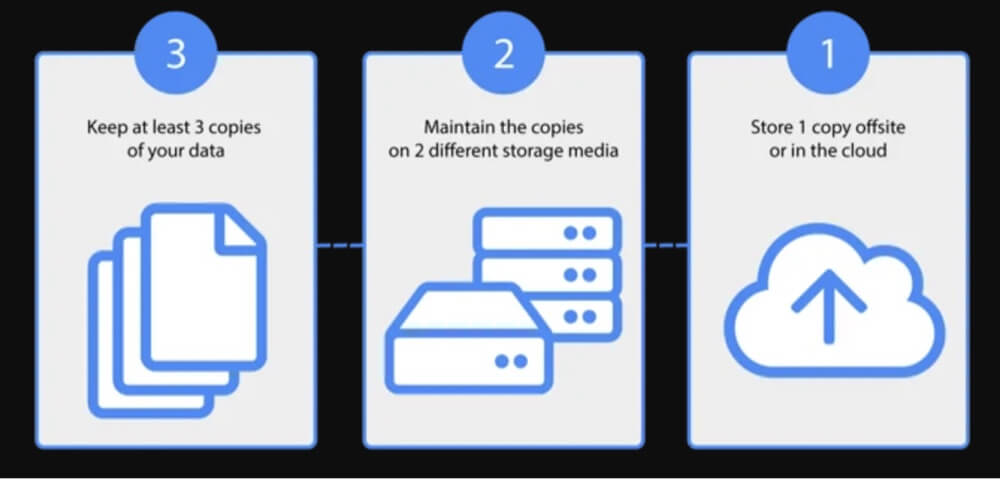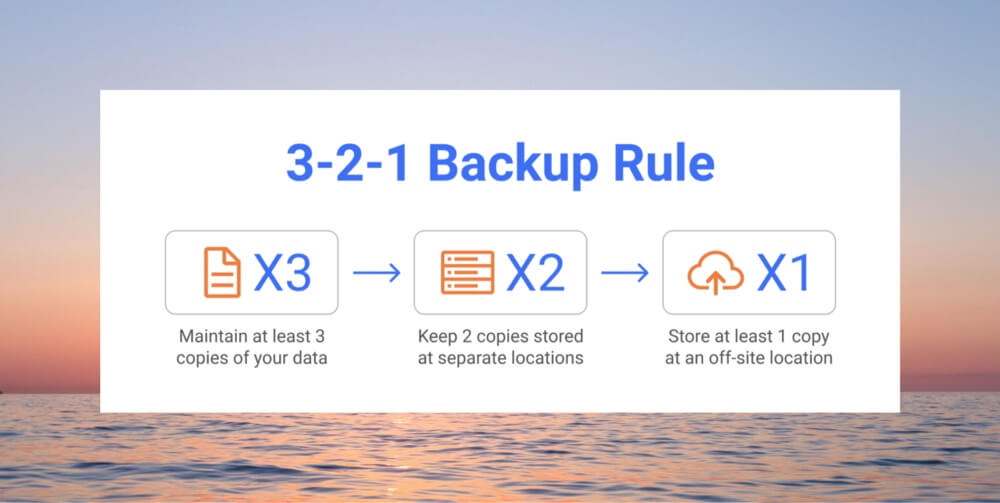Before we start: Donemax Disk Clone is a powerful disk cloning program. It supports to clone everything from a computer to an external hard drive, making a full bootable clone backup. It could be a great tool for backing up your Windows or macOS data or cloning an HDD to a SSD.
PAGE CONTENT:
In today's digital world, our lives revolve around data. From cherished family photos and critical business documents to software code and sensitive client information, digital data has become one of our most valuable assets. But with that value comes vulnerability - data loss can occur at any moment due to hardware failure, human error, theft, ransomware attacks, or natural disasters. That's where the 3-2-1 backup rule comes in.

The 3-2-1 backup strategy is one of the most widely recommended and time-tested frameworks for backing up data. Whether you're an individual user, a small business, or a large enterprise, understanding and implementing this rule can be the difference between total data loss and fast recovery.
What is the 3-2-1 Backup Rule?
The 3-2-1 backup rule is a simple yet powerful strategy that helps ensure your data is protected and recoverable in case of loss or damage. It is summarized as:
- 3 total copies of your data
- 2 copies stored on different types of media
- 1 copy stored offsite
![3-2-1 backup rule]()
This approach was popularized by photographer and digital asset management expert Peter Krogh, who first introduced it in his book The DAM Book: Digital Asset Management for Photographers. Though its roots are in photography, the strategy applies universally to all forms of data.
Let's break it down.
Understanding the 3-2-1 Components
1. Keep 3 Copies of Your Data
This includes the original data and two backups. The idea here is to avoid single points of failure. If one copy becomes corrupted or lost, the others can act as a fallback. This redundancy is crucial for ensuring business continuity or personal data security.
Example:
- Your working file on a laptop
- A backup on an external hard drive
- A third copy in cloud storage
Even if the primary data is compromised - whether by malware, accidental deletion, or hardware issues - you'll have at least two safe copies elsewhere.
2. Store Data on 2 Different Media Types
Diversifying your storage medium reduces the risk associated with device-specific failures. Relying on just one type of device (e.g., two external HDDs from the same brand) isn't optimal because both may be vulnerable to similar failures or flaws.
Different media types might include:
- Internal hard drive (HDD/SSD)
- External HDD or SSD
- USB flash drives
- DVDs or Blu-ray discs
- Network-attached storage (NAS)
- Cloud storage platforms
Example:
- One copy on your computer
- One on a USB drive
This diversification protects against both mechanical failure and compatibility issues that could arise in the future.
3. Store 1 Backup Offsite
Storing a copy offsite is perhaps the most critical step for protecting against physical threats like fire, flood, or theft. If all copies are stored in the same physical location (your home or office), they're equally vulnerable to local disasters.
Offsite storage options include:
- Cloud storage services like Google Drive, Dropbox, or iCloud
- Backup services like Backblaze or Carbonite
- Physical storage at a different location (e.g., bank deposit box or a trusted friend's house)
- Remote servers or data centers
Even a reliable external hard drive is useless if it's destroyed in the same event that wipes out your computer. Offsite storage ensures at least one version remains safe.
Why the 3-2-1 Rule Still Matters Today?
With the rise of cloud technology and sophisticated backup tools, some people question whether the 3-2-1 rule is still relevant. The answer: absolutely.
Reasons It's Still Vital:
- Cyberattacks: Ransomware can encrypt your files and local backups.
- Hardware failures: Even solid-state drives (SSDs) have limited lifespans.
- Natural disasters: Fires or floods can destroy all onsite storage.
- Human error: Mistaken deletions or formatting can wipe important data.
- Software corruption: OS crashes or app bugs can damage files.
The 3-2-1 rule provides a robust defense against these threats by ensuring that even if one or two copies are compromised, the third can be used to restore data.
Real-World Benefits of the 3-2-1 Backup Strategy
Improved Data Resilience
Having multiple copies on different media and locations reduces the chance of total data loss.
Scalability
The 3-2-1 approach scales easily from individual users to large organizations with minimal changes.
Business Continuity
Organizations can restore operations quickly after disruptions, avoiding costly downtime.
Cost-Effective
Many of the required tools (external drives, cloud storage) are affordable and accessible.
Peace of Mind
Knowing your critical data is securely backed up gives you confidence in facing unexpected events.
How to Implement the 3-2-1 Rule?
Implementing the 3-2-1 rule doesn't require expensive hardware or IT expertise. Here's a practical guide:
1. Identify What Needs Backing Up
Start by identifying critical files:
- Documents, spreadsheets
- Photos, videos, design assets
- Financial or legal records
- Application and OS settings
2. Choose Your Media
Mix and match storage types:
- External SSDs/HDDs for local backups
- USB flash drives for quick, portable options
- DVDs for long-term archiving
- NAS for home or office networks
3. Select an Offsite Backup Method
Popular cloud platforms:
- Google Drive (15GB free, paid plans for more storage)
- Dropbox
- Microsoft OneDrive
- Apple iCloud
- Backblaze or Carbonite for automated continuous cloud backups
4. Automate the Process
Manual backups are prone to human error. Automating the process ensures consistency and saves time.
For Windows:
- File History - Backs up files to an external drive or network location
- Backup and Restore (Windows 7) - Legacy tool still available in Windows 10/11
- Donemax Disk Clone - Disk tools for full disk cloning and scheduling
For macOS:
- Time Machine - Built-in, reliable, supports hourly, daily, and weekly backups
- External tools: Donemax Disk Clone for Mac, SuperDuper!
For Linux:
- Deja Dup, rsync, or Timeshift - For scheduled backups and snapshots
Cross-platform Solutions:
- Acronis Cyber Protect Home Office - Disk imaging, file backup, ransomware protection
- EaseUS Todo Backup - Easy-to-use, supports incremental backups
- SyncBack - Great for custom file syncing and backup scripts
💡 Tip: Set backups to run at night or during idle hours to avoid performance drops.
5. Test Your Backups Regularly
Many users forget to test whether backups are recoverable. Perform periodic restore tests to verify data integrity and reliability.
User-Specific Example Implementation
Home User Example:
- Photos and documents backed up via Time Machine (local HDD)
- Same photos synced to Google Drive (offsite)
- Additional copy of family videos on a second USB kept at a sibling’s house
Small Business Example:
- Files stored on office NAS (redundant local copy)
- Daily backups to an external HDD
- Automated nightly backup to Backblaze cloud account
Freelancer Example:
- Codebase stored on laptop (original)
- Synced to GitHub and external SSD (second media)
- Monthly encrypted archive uploaded to Dropbox (offsite)
Recap of Steps
- Identify valuable data
- Choose two different storage media
- Pick an offsite backup method
- Automate everything
- Test regularly
Once you complete these five steps, you'll have a rock-solid 3-2-1 backup system in place - giving you peace of mind and preparedness for unexpected data disasters.
Modern Variations of the 3-2-1 Rule
As data environments evolve, so does the 3-2-1 strategy.
▪️ 3-2-2 Rule
This expands the offsite protection by storing two copies offsite, ideally on different platforms (e.g., one cloud and one cold storage).
▪️ 4-3-2 Rule
Used by enterprises for greater fault tolerance:
- 4 total copies
- 3 types of media
- 2 stored offsite
▪️ Air-Gapped Backups
An air-gapped backup is physically isolated from other systems, making it immune to network-based attacks (ideal for protection against ransomware).
▪️ Immutable Backups
Immutable backups cannot be modified or deleted for a set retention period, protecting from internal threats or accidental deletion.
Common Mistakes to Avoid When Backing Up Data
Avoid these pitfalls when implementing the 3-2-1 rule:
▪️ Storing All Copies in One Location
This defeats the purpose of offsite backups.
▪️ Using Same Media Type for All Copies
For example, three USB drives are not media diversity.
▪️ Not Verifying Backups
Unverified backups may be corrupt or outdated.
▪️ No Encryption for Cloud Backups
Always encrypt sensitive data before uploading to cloud platforms.
▪️ Infrequent Backups
Backing up once every few months may leave you exposed to massive data loss in between.
Conclusion
Data loss is not a matter of if, but when. Whether due to human error, hardware failure, malware, or natural disasters, the risks are real and costly. The 3-2-1 backup rule provides a proven, practical framework to ensure your data is always safe, secure, and recoverable.
With just a bit of planning and the right tools, you can implement this strategy today. And when the unexpected does happen - and it likely will - you'll be glad you did.
FAQs About Backup Rule
1. Is the 3-2-1 backup rule still relevant in the age of the cloud?
Yes. Even with cloud storage, redundancy and offsite strategies are critical to mitigate risks like accidental deletion or cloud outages.
2. Can cloud storage count as two copies?
No. If you store a file in Google Drive and sync it across devices, it's still one logical copy. Use a different cloud service or backup medium to satisfy the "two media" rule.
3. How often should I back up my data?
It depends on how frequently your data changes. For active users or businesses, daily backups are ideal. Weekly may suffice for personal use.
4. Do smartphones and tablets need backups too?
Absolutely. Use iCloud or Google Backup for mobile devices and consider periodic manual backups to a computer or external drive.

Donemax Disk Clone
An award-winning disk cloning program to help Windows users and Mac users clone HDD/SSD/external device. It also can create full bootable clone backup for Windows PCs and Macs.
Related Articles
- Dec 24, 2024How to Clone Old NVMe SSD to New NVMe SSD?
- Apr 23, 2024How to Change Primary Hard Drive on Windows 10?
- Apr 21, 2024How to Upgrade HDD/SSD to Large Disk Without Data Loss?
- Mar 26, 2024How to Move OS to Samsung NVMe SSD?
- Jun 06, 2025Clone Hard Drive with Command Prompt
- Jun 04, 2025How to Clone FAT32 Drive to exFAT Drive?

Steven
Steven has been a senior writer & editor of Donemax software since 2020. He's a super nerd and can't imagine the life without a computer. Over 6 years of experience of writing technical solutions and software tesing, he is passionate about providing solutions and tips for Windows and Mac users.

Gerhard Chou
In order to effectively solve the problems for our customers, every article and troubleshooting solution published on our website has been strictly tested and practiced. Our editors love researching and using computers and testing software, and are willing to help computer users with their problems
